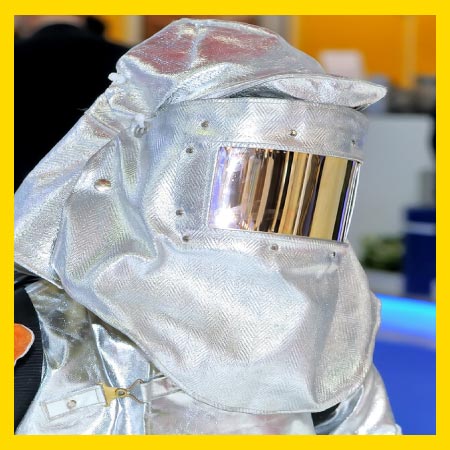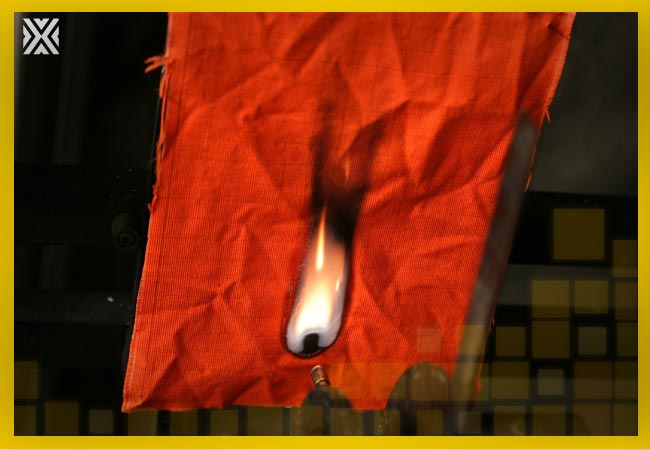Currency
June 03, 2022

Managing the risks involved in the working environment is always necessary in order to protect workers and to maintain compliance with health and safety legislation. In terms of thermal protection, a wide range of PPE (Personal Protective Equipment) clothing exists typically produced from inherently heat and flame resistant materials.
Three intended safety standards available to manufacturers producing PPE garments protecting workers against heat and flame hazards cover the following:
• EN ISO 11612:2015 – Protective Clothing against Heat and Flame
• EN ISO 11611:2015 – Protective Clothing for use in welding or allied processes
• EN ISO 14116:2015 – Protective Clothing against Flame, Limited Flame Spread materials, material assemblies and clothing
Note that these dual “EN ISO” standards also hold a “presumption of conformity” within the European Union provided the manufacturer also adheres to the requirements of the European PPE Regulation (EU) 2016/425. Currently each of these standards are under review as part of the 5 yearly standard review process and new versions of these are expected in the coming months.
“often, heat and flame protective clothing can meet more than one standard and additionally comply with other clothing protection standards”
EN ISO 11611 and EN ISO 11612 are specifications for garments providing protection against heat transmission as well as against flame spread. ISO 14116, however, is a specification for resistance to flame spread garments only. Other international standards for clothing protecting against heat and flame are available such as those produced by ASTM for the USA, AS/NZS (for Australia and New Zealand) – these are not considered in this article. Often, heat and flame protective clothing can meet more than one standard and additionally comply with other clothing protection standards such as EN ISO 20471:2013 (High Visibility), IEC 61482 (Thermal hazards of an electric arc) and EN 13034: 2005 (Chemical Protection).
SATRA can both test and certify garments to these international heat & flame standards which have mandatory garment tests for properties such as, limited flame spread, seam strength and design. Other claims can come from tests on the outer fabric.
All three standards share the same flame resistance test (Limited Flame Spread) – ISO 15025, which requires garment testing before and after pre-treatment or cleaning in line with the manufacturer’s instructions. Washed seams are tested along with all outer materials which includes retro reflective tape, hardware (e.g. zips) and badges etc. Single-use/disposable or leather garments are exempt from this pre-treatment.

In order to be fully compliant with these standards, manufacturers need to have the garments tested after pre-treatment processes based on the care labels and user information the manufacturer intends to apply to the garment. The care label should specify the type of cleaning treatment, the temperature and the maximum number of cleaning cycles the garment may undergo before its protective performance no longer complies with the standard. For example a care label for a protective garment might specify that the garment should be industrially laundered at 75°C and also that the garment should be discarded after 10 cycles because it may no longer be adequately protective. A test house responsible for testing this garment would then carry out testing after 10 cycles of industrial washing according to ISO 15797 at 75°C.
If the manufacturer has not specified a maximum number of cleaning cycles, then these standards specify as a default, 5 wash cycles. However, in such cases, the manufacturer must refer to this number of laundry cycles on the care label and information for use leaflet which should be supplied with each garment. In the case of CE marked garments for the European market it is mandatory that this information for use leaflet accompanies each garment when sold. Should the manufacturer decide that the garment should not be laundered, the care label must display negative symbols only (i.e. symbols with crosses through them) for example do not launder/do not dry clean.
Inherently flame retardant fabrics should not lose their limited flame spread properties provided a build-up of contamination is avoided. Similarly, correctly treated flame retardant fabrics should keep their limited flame spread properties until after the garment has deteriorated through a combination of use, wear and cleaning. Manufacturers may wish to emphasise this in their user instructions.
“inherently flame retardant fabrics should not lose their limited flame spread properties provided a build-up of contamination is avoided”
In terms of specific claims about limited flame spread properties and thermal protection properties, the manufacturer should only make claims which can be backed up by test data. For example, if a manufacturer’s user information leaflet and label states that a garment can be washed 25 times, it is stating that the garment will be adequately compliant with the standard up to this point and that these claims have been tested.
https://www.hsimagazine.com/article/heat-and-flame-protective-clothing/
Three intended safety standards available to manufacturers producing PPE garments protecting workers against heat and flame hazards cover the following:
• EN ISO 11612:2015 – Protective Clothing against Heat and Flame
• EN ISO 11611:2015 – Protective Clothing for use in welding or allied processes
• EN ISO 14116:2015 – Protective Clothing against Flame, Limited Flame Spread materials, material assemblies and clothing
Note that these dual “EN ISO” standards also hold a “presumption of conformity” within the European Union provided the manufacturer also adheres to the requirements of the European PPE Regulation (EU) 2016/425. Currently each of these standards are under review as part of the 5 yearly standard review process and new versions of these are expected in the coming months.
“often, heat and flame protective clothing can meet more than one standard and additionally comply with other clothing protection standards”
EN ISO 11611 and EN ISO 11612 are specifications for garments providing protection against heat transmission as well as against flame spread. ISO 14116, however, is a specification for resistance to flame spread garments only. Other international standards for clothing protecting against heat and flame are available such as those produced by ASTM for the USA, AS/NZS (for Australia and New Zealand) – these are not considered in this article. Often, heat and flame protective clothing can meet more than one standard and additionally comply with other clothing protection standards such as EN ISO 20471:2013 (High Visibility), IEC 61482 (Thermal hazards of an electric arc) and EN 13034: 2005 (Chemical Protection).
SATRA can both test and certify garments to these international heat & flame standards which have mandatory garment tests for properties such as, limited flame spread, seam strength and design. Other claims can come from tests on the outer fabric.
All three standards share the same flame resistance test (Limited Flame Spread) – ISO 15025, which requires garment testing before and after pre-treatment or cleaning in line with the manufacturer’s instructions. Washed seams are tested along with all outer materials which includes retro reflective tape, hardware (e.g. zips) and badges etc. Single-use/disposable or leather garments are exempt from this pre-treatment.

Cleaning according to care label
In order to be fully compliant with these standards, manufacturers need to have the garments tested after pre-treatment processes based on the care labels and user information the manufacturer intends to apply to the garment. The care label should specify the type of cleaning treatment, the temperature and the maximum number of cleaning cycles the garment may undergo before its protective performance no longer complies with the standard. For example a care label for a protective garment might specify that the garment should be industrially laundered at 75°C and also that the garment should be discarded after 10 cycles because it may no longer be adequately protective. A test house responsible for testing this garment would then carry out testing after 10 cycles of industrial washing according to ISO 15797 at 75°C.
If the manufacturer has not specified a maximum number of cleaning cycles, then these standards specify as a default, 5 wash cycles. However, in such cases, the manufacturer must refer to this number of laundry cycles on the care label and information for use leaflet which should be supplied with each garment. In the case of CE marked garments for the European market it is mandatory that this information for use leaflet accompanies each garment when sold. Should the manufacturer decide that the garment should not be laundered, the care label must display negative symbols only (i.e. symbols with crosses through them) for example do not launder/do not dry clean.
Inherently flame retardant fabrics should not lose their limited flame spread properties provided a build-up of contamination is avoided. Similarly, correctly treated flame retardant fabrics should keep their limited flame spread properties until after the garment has deteriorated through a combination of use, wear and cleaning. Manufacturers may wish to emphasise this in their user instructions.
“inherently flame retardant fabrics should not lose their limited flame spread properties provided a build-up of contamination is avoided”
In terms of specific claims about limited flame spread properties and thermal protection properties, the manufacturer should only make claims which can be backed up by test data. For example, if a manufacturer’s user information leaflet and label states that a garment can be washed 25 times, it is stating that the garment will be adequately compliant with the standard up to this point and that these claims have been tested.
SOURCE:
https://www.hsimagazine.com/article/heat-and-flame-protective-clothing/









